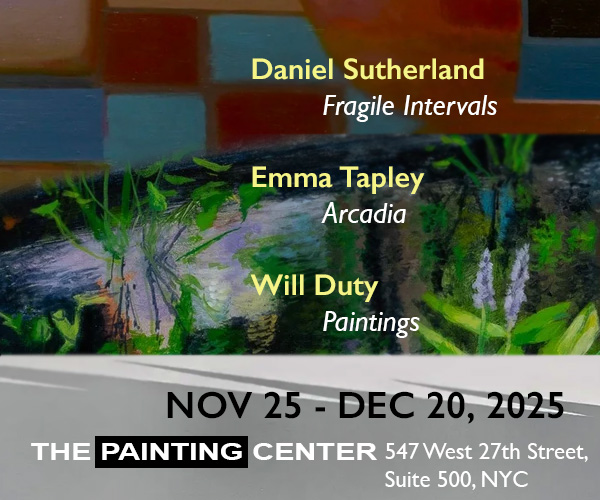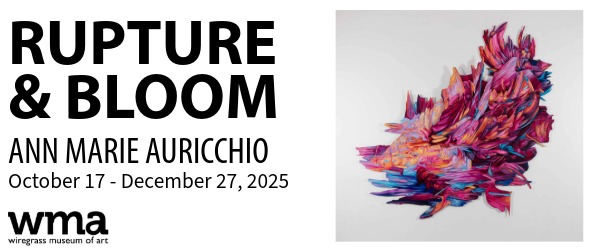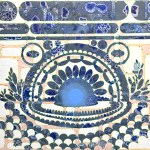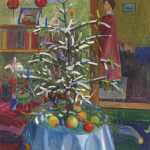
Contributed by Sharon Butler / Rhia Hurt grew up in Northern California where she studied art and education, earning two Masters degrees–an MA in teaching from UC Santa Cruz and an MFA in painting from San Francisco Art Institute. After teaching public school for many years, she moved to New York, where, in 2012, she and a few other artists founded Trestle Art Space. On the occasion of �Seeing Through,� Hurt�s solo show on view at Ground Floor Gallery, we got together to discuss her new work and her engagement with color, ephemeral forms, transparency, and the mystery of the things we cannot see.






Sharon Butler: I feel as though I�ve been watching you make some interesting moves since I visited your studio a few months ago. During our visit, you were working on the large stacked ovoid watercolors, the small grouped paintings of circular shapes that look like swatches. You were beginning to think about making larger three-dimensional pieces. It�s as if you are in the process of developing a visual language rooted in ephemeral forms and transparency.
Rhia Hurt: I�ve been exploring some ideas that focus on letting form, color, and relationships between positive and negative space drive my decisions. I try to follow my instinct, set up material and color challenges and then look for solutions to the problems I�ve set for myself. I experiment with surfaces� pushing paint and color to the point where it sort of falls apart and behaves in a way I didn�t expect. I also started to think about composition as a challenge, too, subverting my own rules to create both positive and negative spaces in various ways. The three dimensional work came out of these experiments. This vocabulary has come out of observing my surroundings and then letting my imagination play out ideas inspired by looking.
SB: Tell me about your color choices. You seem drawn to the most beautiful saturated color. I wonder if the choices are purely intuitive or whether you think more deeply about color as content.
RH: I think both of those things are true. I explore how color works through a not so linear process. I love teachers like Joseph Albers who focused on the relative relationships that come from placing color side by side, and awareness of associations, color �biases,� and color theory in general. I pay attention to value, and the weight and feel of color combinations. I also like when chance plays a part. For instance, the way paint mixes to create gradients, saturated or muted color. Depending on the chemistry of the pigment and binder, different things can happen. So, although optics and light/color operate in a more predictable way in physics, the actual material properties of pigments play a big part in how I use color. It�s not formulaic� color surprises me. Certain pigment particles sink like sediment in a river bed when thinned out, while others float creating interesting optical blends. Using acrylic paint can make a thin, plastic edge of color that shrinks as it dries to create shore lines. It�s intuitive to a degree, but the color combinations I�m looking for come from observing nature and it�s variance in naturally occurring edges (like the rust stain on the side of a cement building, the light gray/yellow glow around the moon, or teal/violet ripples in water) and the interest I have in experimenting with paint.
SB: You�re drawn to the landscape and your work is rooted in the visual world, but at the same time you suggest that a non-physical world feels equally present. You once said that you think about the space between us and our thoughts. That�s the great unknown�we can never know what someone else is thinking, but some people are more intuitive than others. This idea manifests in the way you make paintings and then craft objects of the space between. There is a switch though�the thing that is the most physical becomes an illusion, and the thing we imagine becomes a sculptural object.
RH: I like how you describe that switch. I�m drawn to landscape, nature, and material, and letting things remain a mystery. For me, time in the studio is time to reflect and be in touch with different types of ideas and feelings that might not be totally clear� until I make something to try to express it or see it from a different angle. I�m not the best at intuiting what someone else thinks or feels (even my own feelings are out of reach from understanding at times), but I can honor and give the space for those thoughts and feelings. The unknown is part of what keeps us connected and intact� in the way that space creates the edge that defines form, and vice-versa.
I think art can be a way to combine disparate thoughts. How a net-like lattice can be an armature for paint, or a fence; how intersecting gestural lines could be figures or chain link. An ovoid shape could look like a color field, or water, or sand, or a rock, or a void. I think about point of view, our experiences and expectations. I like to read poetry because it opens up my understanding of different narratives. There’s somewhat of an open-ended interpretation, and empathy that�s invited� even within topics that have to do with history and identity. As Elizabeth Alexander wrote: �Many things are true at once.�

SB: Do you feel as if your work might be moving away from landscape imagery or are you just as involved albeit with a more abstract approach? How has daily life contributed to the ideas in your work?
RH: I�m not sure. I�ve always been interested in abstraction because of its power to both surprise me and engage the viewer in interpreting the work through associations. My daily life/ experiences have a direct link to what I make in the studio. Life is complicated. Art making helps me slow things down and notice how moments and pieces make a bigger picture. I take visual notes from walking in industrial areas of Brooklyn, when I�m at city playgrounds with my son, and when we play at home with clay, blocks, and toys. All these things add up, and they inform the imagery and structures I explore in the studio.

SB: Tell me about these sculptures that have thin net-like fabric draped on them. They have depressive gestures and dimmer color that both strike me as far less joyful than the paintings. Do you see them as figurative? What are some of the decisions you made to get to this point?
RH: The wire sculptures are a somewhat new territory for me. I�m interested in how gesture becomes a drawing in three dimensional space. I want the structures to be simple, to balance on their own, and to support the delicate-looking paintings on silk. I don�t totally understand them yet but I like painting a line, I like the feeling of movement, and the relationships between materials. I like that you can see through them. The structure and composition change depending on your point of view.

SB: If you had a manifesto about your work, what would the first five items be?
RH: 1. Reflect on my experiences. 2. Learn from my experiences. 3. Use materials experimentally. 4. Look for discoveries. 5. Make these discoveries the basis for new inquiries.
SB: I imagine your involvement at Trestle has informed your work.
RH: Oh yeah. Working alongside the other Trestle artists, I see an incredible variety of approaches to making art, which has been a privilege. I�ve learned so much by seeing the work of other artists in the gallery, meeting curators, being at the open critiques and art talks that we host. I always felt that art school (and much of academia) puts artificial pressure on students and staff, and the commercial art world doesn�t really value the same quality and diversity of voices that my colleagues at Trestle and I do. Through my involvement at Trestle and other artist-run non-profit art spaces I get to see how artists who work outside the traditional gallery system develop their work and support one another. It�s inspiring to be a part of it.


�Rhia Hurt : Seeing Through,� Ground Floor Gallery, 343 5th Street, Brooklyn, New York. Through July 14, 2019.
Related posts:
Two Coats Selected Gallery Guide: June 2019
Centenary: Mira Schendel
Interview: Emma Soucek on curiosity and loss
Barbara Laube�s coexisting states of mind























Beautiful work, delicate and expressive.
These are beautiful paintings and love how they move into three dimensional space, both as illusions and as sculptures.
Since I also push paint to the brink of breaking down, I was really glad to hear your explanation of that.
Really like an abstract style when someone does it right! Rhia’s colors are so vivid and the texture and sense of a liquid and dripping vibe really make her pieces stand out.
I like the way you think and reflect and how this informs your work. I really enjoyed this interview. It’s given me much to think about. Thank you.